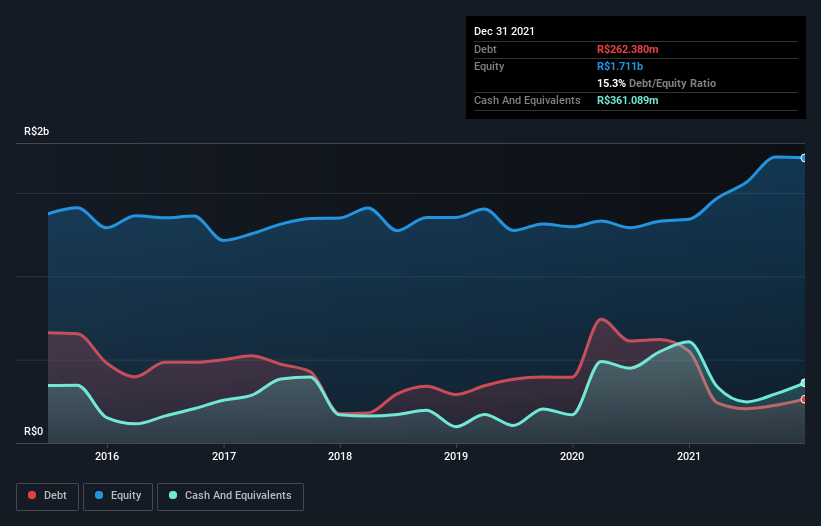Legendary fund manager Li Lu (who Charlie Munger backed) once said, 'The biggest investment risk is not the volatility of prices, but whether you will suffer a permanent loss of capital.' So it might be obvious that you need to consider debt, when you think about how risky any given stock is, because too much debt can sink a company. As with many other companies MAHLE Metal Leve S.A. (BVMF:LEVE3) makes use of debt. But is this debt a concern to shareholders?
What Risk Does Debt Bring?
Debt is a tool to help businesses grow, but if a business is incapable of paying off its lenders, then it exists at their mercy. If things get really bad, the lenders can take control of the business. However, a more common (but still painful) scenario is that it has to raise new equity capital at a low price, thus permanently diluting shareholders. Having said that, the most common situation is where a company manages its debt reasonably well - and to its own advantage. The first thing to do when considering how much debt a business uses is to look at its cash and debt together.
View our latest analysis for MAHLE Metal Leve
What Is MAHLE Metal Leve's Debt?
The image below, which you can click on for greater detail, shows that MAHLE Metal Leve had debt of R$262.4m at the end of December 2021, a reduction from R$552.4m over a year. However, it does have R$361.1m in cash offsetting this, leading to net cash of R$98.7m.

How Healthy Is MAHLE Metal Leve's Balance Sheet?
Zooming in on the latest balance sheet data, we can see that MAHLE Metal Leve had liabilities of R$844.0m due within 12 months and liabilities of R$386.2m due beyond that. On the other hand, it had cash of R$361.1m and R$691.9m worth of receivables due within a year. So its liabilities total R$177.2m more than the combination of its cash and short-term receivables.
Of course, MAHLE Metal Leve has a market capitalization of R$3.21b, so these liabilities are probably manageable. Having said that, it's clear that we should continue to monitor its balance sheet, lest it change for the worse. While it does have liabilities worth noting, MAHLE Metal Leve also has more cash than debt, so we're pretty confident it can manage its debt safely.
Better yet, MAHLE Metal Leve grew its EBIT by 102% last year, which is an impressive improvement. If maintained that growth will make the debt even more manageable in the years ahead. There's no doubt that we learn most about debt from the balance sheet. But it is future earnings, more than anything, that will determine MAHLE Metal Leve's ability to maintain a healthy balance sheet going forward. So if you're focused on the future you can check out this free report showing analyst profit forecasts.
Finally, a business needs free cash flow to pay off debt; accounting profits just don't cut it. MAHLE Metal Leve may have net cash on the balance sheet, but it is still interesting to look at how well the business converts its earnings before interest and tax (EBIT) to free cash flow, because that will influence both its need for, and its capacity to manage debt. Over the most recent three years, MAHLE Metal Leve recorded free cash flow worth 80% of its EBIT, which is around normal, given free cash flow excludes interest and tax. This cold hard cash means it can reduce its debt when it wants to.
Summing up
While it is always sensible to look at a company's total liabilities, it is very reassuring that MAHLE Metal Leve has R$98.7m in net cash. And we liked the look of last year's 102% year-on-year EBIT growth. So we don't think MAHLE Metal Leve's use of debt is risky. When analysing debt levels, the balance sheet is the obvious place to start. But ultimately, every company can contain risks that exist outside of the balance sheet. For example, we've discovered 4 warning signs for MAHLE Metal Leve (3 are a bit unpleasant!) that you should be aware of before investing here.
If you're interested in investing in businesses that can grow profits without the burden of debt, then check out this free list of growing businesses that have net cash on the balance sheet.
New: Manage All Your Stock Portfolios in One Place
We've created the ultimate portfolio companion for stock investors, and it's free.
• Connect an unlimited number of Portfolios and see your total in one currency
• Be alerted to new Warning Signs or Risks via email or mobile
• Track the Fair Value of your stocks
Have feedback on this article? Concerned about the content? Get in touch with us directly. Alternatively, email editorial-team (at) simplywallst.com.
This article by Simply Wall St is general in nature. We provide commentary based on historical data and analyst forecasts only using an unbiased methodology and our articles are not intended to be financial advice. It does not constitute a recommendation to buy or sell any stock, and does not take account of your objectives, or your financial situation. We aim to bring you long-term focused analysis driven by fundamental data. Note that our analysis may not factor in the latest price-sensitive company announcements or qualitative material. Simply Wall St has no position in any stocks mentioned.
About BOVESPA:LEVE3
MAHLE Metal Leve
An automotive parts company, manufactures and sells components for internal combustion engines and automotive filters in South America, Europe, Central and North America, Africa, and internationally.
Adequate balance sheet and fair value.
Similar Companies
Market Insights
Community Narratives



